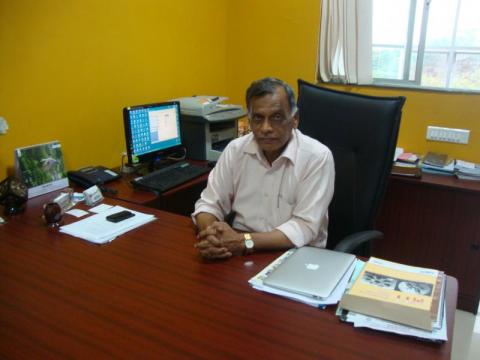
Last week, on the 20th of August, Prof S Mohan received the Academy Excellence Award from Prime Minister Shri Narendra Modi at a function organized by the Defence Research Development Organisation (DRDO) in New Delhi. The award is a fitting recognition for his sustained contributions to innovative technologies for a variety of applications at the DRDO, from display systems in combat aircrafts to micro sensors deployed on defence personnel. We decided to talk to him about his three decade long involvement with the mammoth organization.
“My association with DRDO goes back to 1982”, he said. “Over the last three decades I have been interacting with not just one lab, but more than 20 DRDO labs, in different capacities.”
One of his main contributions has been developing cutting edge technology for direct employment in the defence sector. His laboratory at IISc was instrumental in designing and developing Beam Combiner for a special “Head Up Display” for the light combat aircraft “Tejas”. Pilots need to keep track of many things while flying, which are usually available to them on a display panel, which they have to look down and monitor. However, during combat, it is equally important for pilots to look up to check on incoming aircrafts.
Working closely with the Central Scientific Instruments Organisation (CSIO), where he also served as Director for two years, he was able to design an integrated display system, which allows pilots to see the outside world, combined with other information at a particular wavelength. Bharat Electronics Limited designed the prototype, which was further deployed in about a 100 flights. The device won the groupthe CSIR Technology Award in 1999-2000, and earned felicitation from the former Prime Minister.
Working with a different sector, the Defence Bioengineering and Electromedical Laboratory (DEBEL), he was member of the Research council for projects, which developed a variety of sensors. Defence personnel require specific kinds of suits and sensors that can record and relay a variety of information: body parameters, temperature, oxygen levels etc. These sensors need to be light and small in size, so micro and nano sensors are preferred. They also need electronic equipment, which can transmit signals over WiFi. MEMS – Microelectromechanical systems -- are micro and nano sensors that are compact and lightweight have been a specialty product from his department. Coordinating with about ten labs that work under the DEBEL, he has also been involved in a variety of other projects with a nanotechnology theme.
With the Defence Metallurgical Research Laboratoryin Hyderabad, he has been involved with making special coatings for wear and corrosion resistance, which can help materials withstand tough conditions. Some coatings are extra special, and have the property of “shape memory alloys”. Under a different set of conditions, they can return to their original shape and act as actuators to control circuits that can have other downstream effects. These can have biological, automotive and aerospace applications.
More than research and development projects like the above, Prof Mohan has always been involved in “scientific networking” for realizing technologies for defence. “Since I am part of the research committees and I work closely with about 20 DRDO labs, I have a very good understanding of the expertise available and the needs of the different projects. By matching need and expertise from academic institutions, I have been able to forge relationships that have resulted in innovations,” he said.
There is a third, equally important step in the workflow: the industry. Research labs with different expertise can be brought together, but for a technology to be translated into an actionable form, the industry needs to step in. Prof Mohan is equally well connected with industry sector, and has seen to the fruitful delivery of technology needed for defense.
“The challenge is in getting the different teams to work together, and to get them to deliver in time,” he said.
More information:
Prof S Mohan is a Visiting Professor at the Centre for Nano Science and Engineering, Indian Institute of Science, Bangalore. He also holds a Chair at Central Manufacturing Technology Institute (CMTI), Bangalore and also the Chairman of its Research Advisory Board. He is a Honorary Scientific Consultant – High Technology: Industrial Applications in the office of Principal Scientific Adviser, Government of India.
Website: http://www.cense.iisc.ac.in/s-mohan
